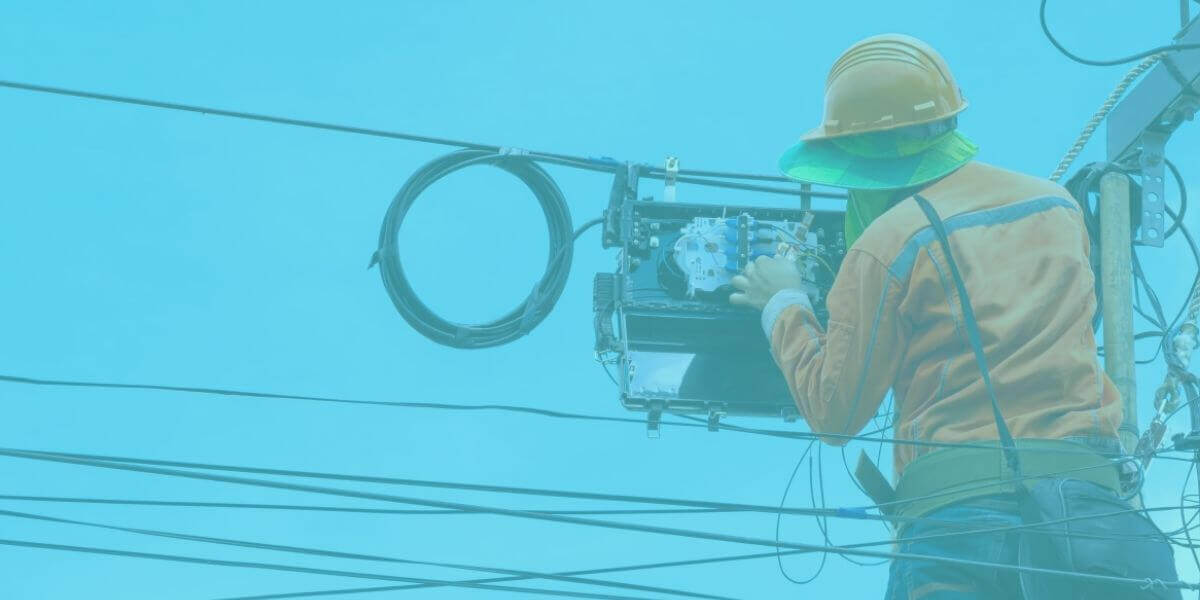Lower your internet bill
61% of people overpay for their internet.
Are you one of them?
Unlock exclusive offers in your area!
Call now
[tel]Enter zip code
1 Star is Poor & 5 Stars is Excellent.
* Required

Written by Rosslyn Elliott - Pub. Mar 05, 2024 / Updated Mar 18, 2024
Table of Contents
Are you happy with your Internet service?

About the author
Switching internet providers feels like navigating a maze blindfolded.
You know better options are out there, but you struggle to escape your unreliable connection. You can’t seem to find your way through all the baffling twists and turns.
It would be a great online game, if you just had a faster internet connection!
Research shows that almost 30% of US households struggle with hurdles when they’re trying to choose an internet provider [1].
This guide breaks down exactly why finding a new ISP causes headaches. Then we’ll explore new tools and resources to simplify your search process.
Online reports cite several core sources of consumer frustration when trying to switch internet providers [2]:
Searching for new providers often starts by googling options in your area. But when you do, things don’t match up. The databases promise as many as 10 ISPs available in your neighborhood. But when you keep exploring, you can only find one or two!
Unfortunately, much of the online data remains stuck in decades past. Historically, dozens of tiny local ISPs served American homes. Nearly all were bought out by today’s biggest players –Spectrum, Optimum, Comcast, etc.
As the market consolidated, the data didn’t always refresh. So those outdated online listings often still reflect vanished regional providers that are long gone. You get the illusion of abundant choice in places where there are now only two internet provider options.

Conflicting information
To make the maze even more complex, internet pricing can vary widely even across the same city [3].
Providers keep an eye on rival promotions between neighborhoods. Then, ISPs constantly adjust rates to undercut competitors in a tight market. Meanwhile, they squeeze more profits where they face no competition.
Service can cost far more per year on one neighborhood block than on the next street over. This hyper-localized strategy tries to poach customers from nearby rivals while keeping rates high in areas lacking alternatives.
For consumers, such inconsistent pricing can crush any chance at reasonable price comparisons. You might land an unbeatable rate, but that rate is unavailable for your near neighbors.
That is why so often, internet companies try to hide what they are charging across the board. They don’t want people to know where prices are varying and why. The good news, though, is that pricing transparency is becoming more common. In our staff reviews, we point out the internet providers who use fair, consistent pricing.
Even if you can get through the pricing confusion, more challenges are waiting.
Providers are giving both too much data and not enough on their public websites. With patchy data, how can you accurately compare speeds, connection reliability, customer support and contract terms?
There’s truth, and then there’s marketing, and consumers know that not everything they read online may be reliable.
Overwhelmed by trying to figure out the alternatives, consumers freeze. Who can tell the risk of actually switching if it’s too hard to compare internet plans?

Too much research
Information problems complicate the provider search, but new solutions aim to help you cut through the confusion:
The FCC’s official National Broadband Map of 2023 provides location-specific provider availability nationwide [4]. The accuracy is not perfect. Legislators have challenged some of the data that ISPs give to the government [5].
But at least the map is a step forward. It also shows overall stats, such as how much fiber is available in a certain region.
CompareInternet.com can transform superficial ISP listings into transparent performance profiles.
Beyond listing basics like speed and pricing, we provide intel defining real-world satisfaction:
We help you avoid decision-making pitfalls by giving you all the info you need.
Still overwhelmed by all the information?
Plan-match quizzes will ask you about your common internet activities. With a few clicks, you can tell the quiz how many devices you might be using, whether you are an online gamer, and other key info.
These tools can answer all the hardest questions like how much speed you need. Along with our helpful resources on how much data you are likely to use, these tools can speed up your ISP search.
The quiz will recommend suitable plans for you, which helps you make your choice for the best ISP in your area.
Looking at online reviews from users can give you a general idea about a few aspects of an ISP’s services. We do have consumer reviews here on CompareInternet.com.
But consumer reviews tend to cover only one or two strengths or weaknesses. Users will tell you if the internet connection was fast, and whether the customer service was shaky.
That’s good info, but you’ll also need to know a lot more to predict your ISP experience.
Look at the comprehensive provider reviews on our site. You can get an overall understanding of major national internet providers (and regional ISPs too). We also have comparison tools where you can match up selected providers head-to-head.

Expert staff reviews
If you ask these four key questions, you can set yourself up for success when choosing an ISP.
Cheap intro rates can be really tempting. But remember to plan for your full costs, including hardware rentals, hidden fees, and early termination penalties.
Know your true average monthly internet cost to avoid money headaches. Be aware not only of what you will pay now, but how those costs might change in 6-12 months.
Be clear in your own head about your internet usage.
Unnecessary internet speed is like an unused gym membership. Don’t overspend on gigabit speeds because it sounds awesome. If you mainly stream shows and browse the internet, those blazing speeds won’t affect your experience. Save your cash.
Your level of comfort with technology may also affect your decision. Some people need more help troubleshooting for connection issues. Check out tech support satisfaction ratings beforehand.
Billing clarity and accuracy is also important. Having to call to clarify confusing charges tests anyone’s patience.

Good tech support?
If you think you may need to move, make sure your ISP either is able to go where you go or will not charge you a cancellation fee. Fortunately, more and more providers are offering no-contract service. Sneaky early termination fees are no fun down the line.
A few additional speed bumps complicate the journey to improved internet:
Many people don’t understand the way internet providers talk about speed.
You will notice if you look at ads that even the fastest internet packages use the words “up to” when they mention internet speeds. Why? Because “up to 200 Mbps” typically references only your connection potential or “up to” speed. Actual performance can fall below those peaks due to congestion, usage demands, etc.
The most misleading ads tend to be DSL, which may advertise speeds “up to 100 Mbps” when many customers actually get up to 10 Mbps.
But thanks to pressure for more transparency, even most DSL providers will now tell you your approximate real speeds when you sign up for a plan. Just don’t take that 100 Mbps seriously until you enter your own zip code and get the facts!
You shouldn’t need a networking PhD to understand internet plans. But confusing technical language may distract you from the actual basic terms you need to choose the best internet plan. Pay little mind to jargon like “packet loss” unless you truly understand the impacts. Focus on real usage and a few terms like Mbps vs Gbps and bits vs bytes.
Make sure you check out our expert reviews for the lowdown on hardware rental fees, data overage penalties, installation and activation costs. Any surcharges or early termination rules? It pays to know the true total cost of ownership before you sign, not after unexpected charges hit.

Surprise fees
By now you’ve heard some advice that will give you some clarity in the confusing ISP search. Here are a few more tips to get you through the maze.
If you are lucky enough to have multiple options for ISPs, create a checklist:
Having defined standards keeps you from overthinking every offer you see.
Consult our free library of resources that can explain anything you need to know.
Curious about why today’s cable internet is so fast, but still doesn’t have fiber-like speeds? We have an article about HFC that will answer everything!
Want an overview of best cheap internet plans? We’ve got you covered.
Getting word-of-mouth advice can be helpful when you want to know about outages or customer service. Try Nextdoor.com, neighborhood Facebook groups and chatting with the folks next door.
As tough as it is to ignore that shiny new toy, don’t obsess over bonus features you don’t need. Sure, smart home device integration or bundled subscriptions sound great. But don’t get distracted by anything that won’t apply to you and your household for a while. Stick to your key checklist.

Ask your neighbors
The single biggest obstacle you may face is not having enough ISP options. It’s no wonder frustrations run high if you only have one choice for internet.
But why do most regions lack abundant providers delivering service in the first place?
Here are a few reasons why there is so little competition:
Early on in internet history, there were lots of small dial-up ISPs. Those small providers gradually gave way to mega-corps. Comcast, TimeWarner, CenturyLink and other giants absorbed hundreds of local providers, especially from 2000-2010 [6]. Once a mammoth internet provider got control of a geographic area, it was harder for others to compete.
Building broadband networks demands serious capital. Most companies won’t gamble without guaranteed customers. The problem is that rural areas have fewer customers, so there is less money to be made per mile of infrastructure built.
That’s why high-population areas tend to have more choices. And that’s why sometimes, in the most remote areas, the only ISP choice will be satellite internet.
When competitors try to expand into new regions, incumbent ISPs file legal challenges to undermine progress at every turn. Because infrastructure is so expensive and the opposition from incumbent internet providers is so fierce, it takes a very determined effort to get into a region.
As ISP owner Josh Montgomery explained in Ars Technica, being a smaller provider means a constant fight for survival. The ISP has to make enough money from customers to expand bandwidth, in order to keep customers satisfied, in order to expand even more. “It’s an ongoing problem that you’re solving every day,” Montgomery said [7].
Many US states have laws restricting or banning municipal broadband networks [8]. Without public options driving local market competition, private ISPs maintain pricing power and minimize improvements.

Prices drop with competition
When so many Americans have very limited internet options, the demand intensifies for regulators, lawmakers and industry itself to promote competition.
Here are some of the ways that you could get more choices in your internet providers over the coming years. Keep your ears open to support these causes when you hear about them.
Policymakers must stop anti-competitive practices from giant ISPs. That’s the only way to help some people who are locked into single neighborhood ISP options. You can encourage your representatives to support universal internet access and better options for you.
Shared infrastructure would allow multiple ISPs to deliver services over the same lines and cables [9].
Opening access means that you would end up with many more choices. Giant networks would carry traffic without bias while providers competed to improve customer experience.
When public agencies and private companies work together, they can achieve good results. Creative partnerships between government and business can unlock funding for projects.
For example, the BEAD funding initiative is bringing broadband infrastructure to many rural areas [10]. So take heart, because your internet options may get much better in the next few years!

Fiber internet is coming
Finding a good ISP among limited choices is frustrating. But new tools provide better information to compare providers. This makes your search easier.
Know what speed and reliability you need. Look for accurate data on providers in your area. Use CompareInternet.com to simplify your search.
An affordable, reliable provider that fits your home’s needs is out there. Better information makes it easier to find. So just enter your zip code to get started, and you’ll power past any difficulties in finding an internet provider.
[1] ParksAssociates.com. “Challenges Consumers Face in Choosing An Internet Service Provider."
[2] TechDirt.com. “U.S. ISPs aren’t transparent about prices and speeds."
[3] Quora.com. “Why does the price of Wi-Fi vary from neighborhood to neighborhood?"
[4] FCC.gov. “National Broadband Map of 2023."
[5] ArsTechnica.com. “FCC’s New Broadband Map Greatly Overstates Actual Coverage."
[6] ITSec.asia. “A Brief History of the Internet."
[7] ArsTechnica.com. “One Big Reason We Lack Internet Competition."
[9] MilkenInstitute.org. “Shared Use Infrastructure."
[10] InternetForAll.gov. “Broadband Equity Access and Deployment (BEAD)."

About the author
Congratulations, you qualify for deals on internet plans.
Speak with our specialists to access all local discounts and limited time offers in your area.
[tel]61% of people overpay for their internet.
Are you one of them?
Unlock exclusive offers in your area!
Call now
[tel]Enter zip code